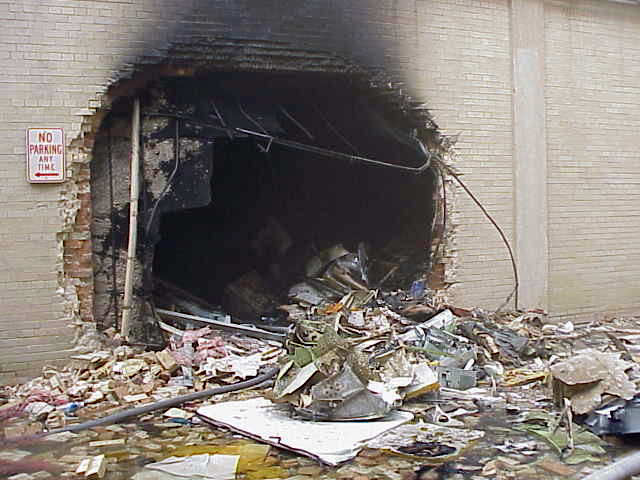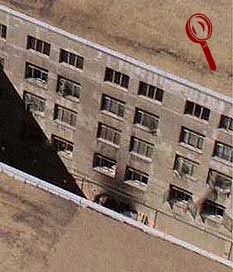
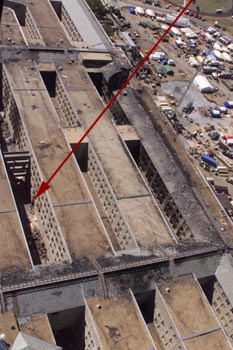 Some
websites, however, claim otherwise. Bizarrely enough, some of these same photos
are cited elsewhere as evidence that a 757 did crash into the Pentagon. The photo below,
for example, supposedly depicts aircraft debris -- and remarkably uncharred
aircraft debris at that. If you're having trouble finding it, here's a hint:
it's the green stuff. If you're wondering how we can be sure that it is in fact
aircraft debris, it's really quite simple: it has to be aircraft debris, you
see, because it's green. Such is the level of investigative analysis employed by
at least one 'debunker.' Before I learned the proper way to identify aircraft
wreckage, I had assumed that the green stuff was probably just broken up office
furnishings of some sort. And I also had no idea that a few flimsy pieces of
debris could cleanly punch out a large hole in a beefy masonry wall.
Some
websites, however, claim otherwise. Bizarrely enough, some of these same photos
are cited elsewhere as evidence that a 757 did crash into the Pentagon. The photo below,
for example, supposedly depicts aircraft debris -- and remarkably uncharred
aircraft debris at that. If you're having trouble finding it, here's a hint:
it's the green stuff. If you're wondering how we can be sure that it is in fact
aircraft debris, it's really quite simple: it has to be aircraft debris, you
see, because it's green. Such is the level of investigative analysis employed by
at least one 'debunker.' Before I learned the proper way to identify aircraft
wreckage, I had assumed that the green stuff was probably just broken up office
furnishings of some sort. And I also had no idea that a few flimsy pieces of
debris could cleanly punch out a large hole in a beefy masonry wall.
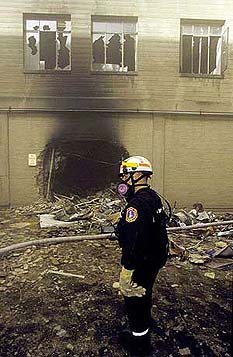
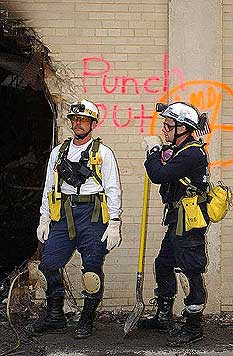
As I explained in my first Pentagon rant, it would have been physically
impossible for the nosecone, or any other component, of a Boeing 757 to punch
out an exit hole in the "C" ring of the Pentagon after plowing through three
entire building rings. As the Los Angeles
Times noted, five days after the attacks, the Pentagon was “built to be
as strong and impenetrable as this country always hoped its military would be …
When ground was broken on the building--eerily, on September 11, 1941, exactly
60 years before Tuesday’s attack--it was a state of the art bunker.”
(http://www.latimes.com/news/nationworld/nation/la-091601pentagon,0,1620389,print.story)
The
Pentagon is an immense, and immensely strong, structure. It is composed
primarily of thick, steel-reinforced concrete. The exterior walls are a full two
feet thick – two feet of solid concrete, brick and limestone (see wall detail,
below left). As a pictorial study of the building noted, “the main interior
walls above the basement level are of masonry” as well. Throughout the entire
complex, spaced roughly fifteen feet apart, in both directions, are thick,
steel-reinforced concrete columns (see example, below right). Also throughout
the complex are “Transformer vaults and machine rooms … protected by masonry
walls and firedoors.” (http://www.greatbuildings.com/buildings/The_Pentagon.html)
The
buildings’ floor slabs are composed of 5.5 inches of steel-reinforced concrete.
To add further to the total mass of concrete that makes up the Pentagon,
“concrete ramps instead of elevators were used to connect the floors,” according
to the Department of Defense’s History of the Pentagon. The same source adds
that, “By 30 April 1942, about eight months after ground breaking, the
contractor completed the first two sections of the building and War Department
personnel began to move in.” (http://www.greatbuildings.com/buildings/The_Pentagon.html)
I
will leave it to the serious conspiracy theorists in the crowd to ponder the
significance of the date of ground-breaking and the date of initial occupation.
The point here is to emphasize the number of thick, dense, reinforced concrete
obstacles that would hinder the forward progress of any projectile attempting to
pass through the Pentagon. To cleanly penetrate just one ring would require
blasting through two 24” thick masonry walls, several masonry interior walls
(notice the cross-section of "E" ring provided by the post-collapse photos),
numerous concrete support columns, and maybe a concrete ramp or a concrete
transformer room. Also, since a 757 fuselage (see below -- and notice, in the
front view, the 'pods' visible on the underside) would not easily fit between
floors, and since the official story claims that the plane entered between the
first and second floors, it would have to rip its way horizontally through a
considerable amount of steel-reinforced concrete floor slab.
The L.A. Times (and many other sources) added
that, in addition to all the reinforced concrete, the portion of the Pentagon
that was hit in the attack had recently been “reconstructed with a web of steel
columns and bars to withstand bomb blasts.” In other words, the Pentagon in
general, and especially the portion affected by the attack, is an extremely well
fortified building. An airplane blasting through three rings of the complex
would be roughly equivalent to an airplane blasting through a whole series of
concrete bunkers.
Another interesting fact about the Pentagon attack that is frequently ignored
is that, in order for the official story to be true, the 'airplane' that hit the
Pentagon had to be flying in an almost perfectly horizontal trajectory at an
extremely low altitude -- mere feet off the ground. And it had to be flying at a
rate of speed that would have allowed it to maintain that trajectory, losing
almost no altitude, even as it was plowing its way through dozens of reinforced
concrete obstacles.
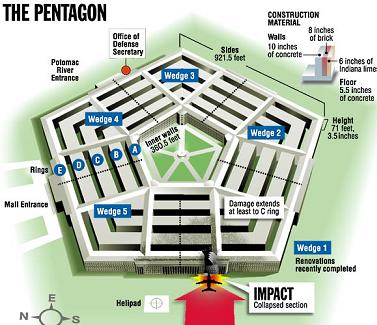



If we were to play along with the official story, we might propose that there are two components of a Boeing 757 that might have had sufficient mass and density to punch out such an exit wound: one of the engines, or a portion of the fuselage that had been thoroughly compacted by previous impacts with dense masonry walls and concrete columns. But again, it must be said that while such components might well have punched through multiple walls in one ring of the Pentagon, they certainly could not have punched cleanly through three entire rings.
(http://www.nfpa.org/NFPAJournal/OnlineExclusive/Exclusive_11_01_01/exclusive_11.01.01.asp)
Arlington County Fire Chief Ed Plaugher, when asked at a Department of Defense news briefing about the presence of jet fuel, responded: "We have what we believe is a puddle right there that the -- what we believe is to be the nose of the aircraft. So -- " (http://www.defenselink.mil/news/Sep2001/t09122001_t0912asd.html)


To account for these reports of surviving nose gear, and to account for an alleged exit hole that couldn't possibly have been punched out by a passenger airplane, I suggested in my previous Pentagon rant that the damage was likely caused by a particular type of cruise missile -- specifically, a Boeing AGM-86C Conventional Air Launched Cruise Missile (CALCM) outfitted with a depleted uranium (DU) warhead. Here are excerpts of what I wrote back in June 2002:
The AGM-86 also can be equipped with a
"penetrating" warhead, designed to cut into hardened bunkers. As the FAS
describes it: "The AGM-86D Block II program is the Precision Strike variant of
CALCM. It incorporates a penetrating warhead, updated state of the art,
near-precision, GPS guidance, and a modified terminal area flight profile to
maximize the effectiveness of the warhead."
The American Scientists also discuss a "feasibility study [which] was concluded in April 1997, in which it was determined the BROACH Warhead on CALCM would offer very significant hard target capabilities ... The BROACH multi-warhead system ... achieves its results by combining an initial penetrator charge (warhead) with a secondary follow-through bomb, supported by multi-event hard target fuzing."
Everything seemed to fit -- the clean initial penetration, the low altitude flight capability, the ability to evade radar, the ability to penetrate multiple reinforced targets. Other researchers apparently liked the fit as well. As I mentioned in Act I, I recently read portions of an online version of David Ray Griffin's book, The New Pearl Harbor. While doing so, I noticed that Mr. Griffin seems to favor the notion that what hit the Pentagon was "one of the latest generation of AGM-type missiles, armed with a hollow charge and a depleted uranium BLU tip." Griffin credits that theory to Thierry Meyssan.Last time I checked, Meyssan was selling a truck bomb theory, so I'm not really sure where he and Griffin picked up that crazy AGM missile theory, but after carefully reviewing the photographic evidence, I can now say with considerable confidence that it wasn't a missile warhead that punched out that exit hole. I can say that because it is perfectly obvious that the 'exit' hole wasn't actually an exit hole at all.
First of all, though no one seems to have given it much serious thought, it is not in the right location to be an exit wound. True, the hole is where it should be if a projectile following the alleged trajectory of the alleged plane sliced through the building in a perfectly straight line from the point of entry. But that would never actually happen in this place that we call the 'real world.' In the real world, when a fast-moving projectile strikes a flat, dense, stationary object at an angle (in this case, an angle of approximately 45 degrees, by most accounts), something called deflection comes into play.
It's been a little while since I had a math or physics class, so I am not going to try to impress anyone here with any complicated calculations -- which would be meaningless to most people anyway (including me). Instead, I am going to make the common sense observation that, due to a projectile's tendency to deflect off of an immovable (relatively speaking) flat surface when striking at an angle, it takes considerably more energy to penetrate at an angle than it does to penetrate head on. And when a projectile does penetrate through an angled surface, the trajectory of that projectile will change due to deflection.
The degree of deflection will largely depend upon the speed and mass of the projectile, and the density of the immovable surface being impacted/penetrated. If the projectile is traveling at sufficient speed and has sufficient mass, and the angled surface offers minimal resistance, then the deflection will be minimal. However, as the projectile's speed decreases with each successive penetration, each subsequent obstacle will offer greater resistance, and, due to the cumulative effects of deflection, will be struck at a progressively sharper angle, so that, after a given number of impacts/penetrations, the projectile will have lost sufficient velocity, and/or it will be traveling at such a severe angle, that it will, rather than penetrating, ricochet off the next masonry wall or concrete column in its path. In the case of the Pentagon, this would happen long before a projectile plowed through three entire rings of the complex.
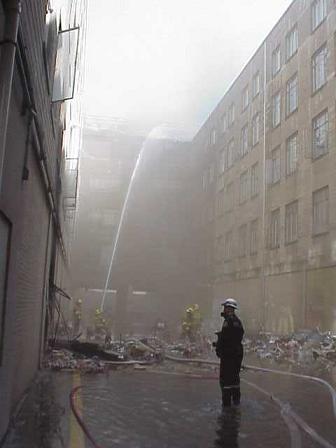 Even if we
were to accept that the projectile did manage, miraculously and in violation of
various laws of physics, to plow a perfectly straight course through three
entire rings of the Pentagon, we would still be left with one rather perplexing
question: if whatever punched that hole still had sufficient mass and velocity
to blast cleanly through two feet of solid concrete, brick and limestone, then
what stopped it from continuing on into the Pentagon's "B" ring? Once it exited
"C" ring, after all, there was nothing between it and the next exterior wall but
about forty feet of air, which doesn't normally offer much resistance. And yet,
according to all reports (and the photo to the left), the damage did not extend
beyond "C" ring. So what exactly was it that stopped the forward progress of the
alleged projectile after it cleanly exited "C" ring?
Even if we
were to accept that the projectile did manage, miraculously and in violation of
various laws of physics, to plow a perfectly straight course through three
entire rings of the Pentagon, we would still be left with one rather perplexing
question: if whatever punched that hole still had sufficient mass and velocity
to blast cleanly through two feet of solid concrete, brick and limestone, then
what stopped it from continuing on into the Pentagon's "B" ring? Once it exited
"C" ring, after all, there was nothing between it and the next exterior wall but
about forty feet of air, which doesn't normally offer much resistance. And yet,
according to all reports (and the photo to the left), the damage did not extend
beyond "C" ring. So what exactly was it that stopped the forward progress of the
alleged projectile after it cleanly exited "C" ring?Below is what is purported to be the official damage report on the Pentagon. Notice that in "C" ring, none of the structural columns in the alleged path of travel suffered significant damage. Just for fun, take a straightedge and try to map out a path of travel from the entry hole to the exit hole that does not pass through one or more of those largely undamaged columns. Let me know if you succeed.
What are we to conclude happened here? Did the strangely indestructible nosecone of Flight 77 somehow weave its way around those columns on the way out of the building? Or did it careen around as if it were in a giant pinball machine until, magically, it somehow ended up right back on course and with sufficient energy to punch its way out? Perhaps I am just a bit of a skeptic, but somehow I find either of those scenarios rather unlikely.
So there are, it seems, at least three questions raised by the existence of the 'exit' hole; how did the projectile plow through dozens of concrete obstructions and yet still retain enough energy to cut cleanly through a two-foot-thick masonry wall? Once it exited "C" ring, what stopped the projectile's forward progress? And how did the projectile manage to avoid hitting a whole series of columns on its way out the newly created back door?

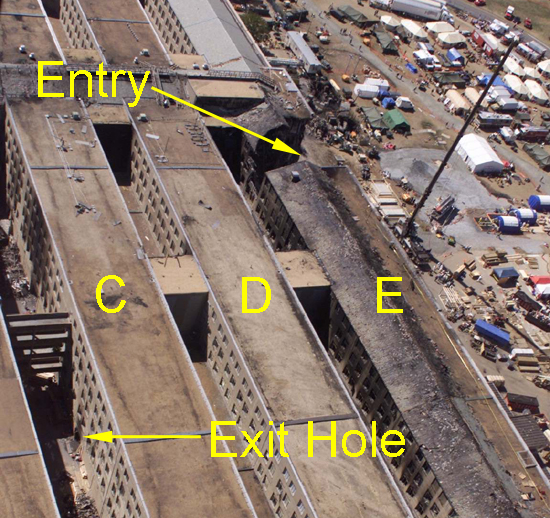
 As the
photo to the left reveals, the space between rings "C" and "D," and between
rings "D" and "E," is not empty space (as I had erroneously believed when I
penned my previous diatribe); rather, those rings are connected, but only for
the first two floors. Notice that that there is no visible damage to the
second-story roof between "C" and "D" rings, nor is there any visible damage to
"C" and "D" rings themselves, with the exception of the blackened 'exit hole'
(and two additional blackened openings in "C" ring apparently created by
firefighters to gain access to the building). It would seem then that there was
no significant damage to the building complex above the second floor, at least
beyond "E" ring.
As the
photo to the left reveals, the space between rings "C" and "D," and between
rings "D" and "E," is not empty space (as I had erroneously believed when I
penned my previous diatribe); rather, those rings are connected, but only for
the first two floors. Notice that that there is no visible damage to the
second-story roof between "C" and "D" rings, nor is there any visible damage to
"C" and "D" rings themselves, with the exception of the blackened 'exit hole'
(and two additional blackened openings in "C" ring apparently created by
firefighters to gain access to the building). It would seem then that there was
no significant damage to the building complex above the second floor, at least
beyond "E" ring. In fact, even in "E" ring, the alleged point of entry, there doesn't appear to have been much significant damage above the second floor. As can be seen in the post-collapse photo above, all the structural columns above the second floor appear to be intact, and, remarkably enough, there doesn't even appear to be a significant amount of fire damage above the second floor. Furniture sitting right next to the point of collapse appears to be unscathed. The same was largely true of the area on the other side of the collapse, as can be seen in the photo to the lower left, which presents a view across the chasm after the clean-up had begun.
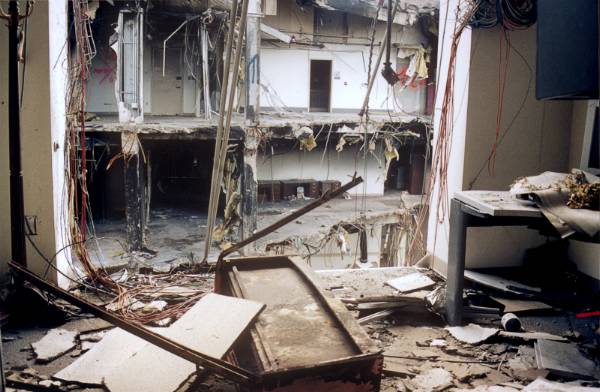
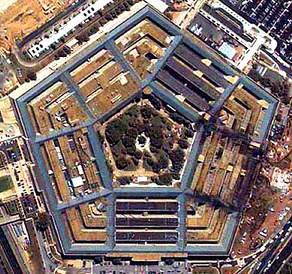 There is
nothing suspicious or unusual, by the way, about the clean break between the
collapsed and standing portions of the building. Some theorists have mistakenly
attached significance to the fact that it looks as though the Pentagon was
cleanly sliced. The truth is that the building gave way at what is known as an
expansion joint (a built-in break to allow for expansion and contraction), which
is exactly where a collapse would be expected to occur, if it was to occur at
all (it is marked as an expansion joint on the damage report presented
previously, and an expansion joint can be clearly seen running along the roofs
of the surviving rings in the aerial photos, directly in line with the 'slice'
in "E" ring).
There is
nothing suspicious or unusual, by the way, about the clean break between the
collapsed and standing portions of the building. Some theorists have mistakenly
attached significance to the fact that it looks as though the Pentagon was
cleanly sliced. The truth is that the building gave way at what is known as an
expansion joint (a built-in break to allow for expansion and contraction), which
is exactly where a collapse would be expected to occur, if it was to occur at
all (it is marked as an expansion joint on the damage report presented
previously, and an expansion joint can be clearly seen running along the roofs
of the surviving rings in the aerial photos, directly in line with the 'slice'
in "E" ring).
But if the vast majority of the significant damage was to the first and second floors only, to such an extent that a second-story roof over a portion of the alleged path of travel shows no visible signs of damage, then we are not really being asked to believe that an enormous 757 jumbo jet disappeared without a trace into a five-story building; incredibly enough, we are actually being asked to believe that it essentially disappeared without a trace into a two-story building!
